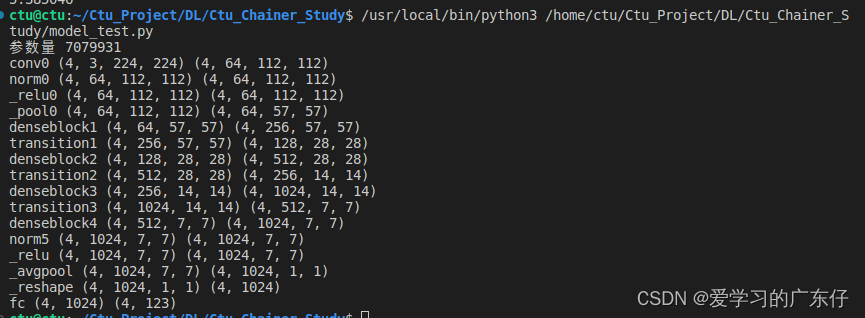chainer-骨干网络backbone-DenseNet代码重构【附源码】
2023-09-27 14:21:00 时间
前言
本文基于chainer实现DenseNet网络结构,并基于torch的结构方式构建chainer版的,并计算DenseNet的参数量。
代码实现
class _DenseLayer(chainer.Chain):
def __init__(self, input_c: int, growth_rate: int, bn_size: int, drop_rate: float):
super(_DenseLayer, self).__init__()
self.layers = []
self.layers += [('norm1',L.BatchNormalization(input_c))]
self.layers += [('_relu1',ReLU())]
self.layers += [('conv1',L.Convolution2D(in_channels=input_c,out_channels=bn_size * growth_rate,ksize=1,stride=1,nobias=True))]
self.layers += [('norm2',L.BatchNormalization(bn_size * growth_rate))]
self.layers += [('_relu2',ReLU())]
self.layers += [('conv2',L.Convolution2D(in_channels=bn_size * growth_rate,out_channels=growth_rate,ksize=3,stride=1,pad=1,nobias=True))]
if drop_rate > 0:
self.layers += [("_dropout1",Dropout(drop_rate))]
with self.init_scope():
for n in self.layers:
if not n[0].startswith('_'):
setattr(self, n[0], n[1])
def forward(self, x):
x = F.concat(x)
for n, f in self.layers:
if not n.startswith('_'):
x = getattr(self, n)(x)
else:
x = f.apply((x,))[0]
return x
class _DenseBlock(chainer.Chain):
def __init__(self, num_layers: int, input_c: int, bn_size: int, growth_rate: int, drop_rate: float):
super(_DenseBlock, self).__init__()
self.layers = []
for i in range(num_layers):
self.layers += [("denselayer%d" % (i + 1),_DenseLayer(input_c + i * growth_rate, growth_rate=growth_rate, bn_size=bn_size, drop_rate=drop_rate))]
with self.init_scope():
for n in self.layers:
setattr(self, n[0], n[1])
def forward(self, x):
features = [x]
for n, f in self.layers:
new_features = getattr(self, n)(features)
features.append(new_features)
return F.concat(features)
class _Transition(chainer.Chain):
def __init__(self, input_c: int, output_c: int):
super(_Transition, self).__init__()
self.layers = []
self.layers += [('norm',L.BatchNormalization(input_c))]
self.layers += [('_relu1',ReLU())]
self.layers += [('conv',L.Convolution2D(in_channels=input_c,out_channels=output_c,ksize=1,stride=1,nobias=True))]
self.layers += [("_pool",AveragePooling2D(ksize=2,stride=2,pad=0))]
with self.init_scope():
for n in self.layers:
if not n[0].startswith('_'):
setattr(self, n[0], n[1])
def forward(self, x):
for n, f in self.layers:
if not n.startswith('_'):
x = getattr(self, n)(x)
else:
x = f.apply((x,))[0]
return x
class DenseNet(chainer.Chain):
cfgs={
'densenet121':{'image_size':224,'growth_rate':32,'block_config':(6, 12, 24, 16),'num_init_features':64},
'densenet169':{'image_size':224,'growth_rate':32,'block_config':(6, 12, 32, 32),'num_init_features':64},
'densenet201':{'image_size':224,'growth_rate':32,'block_config':(6, 12, 48, 32),'num_init_features':64},
'densenet264':{'image_size':224,'growth_rate':48,'block_config':(6, 12, 36, 24),'num_init_features':96},
}
def __init__(self,model_name='densenet121', batch_size=4,channels=3,image_size = 224, bn_size: int = 4, drop_rate: float = 0, num_classes: int = 1000,**kwargs):
super(DenseNet, self).__init__()
self.image_size = image_size
self.layers = []
self.layers += [('conv0',L.Convolution2D(in_channels=channels,out_channels=self.cfgs[model_name]['num_init_features'],ksize=7,stride=2,pad=3,nobias=True))]
output_size = int((self.image_size-7+2*3)/2+1)
self.layers += [('norm0',L.BatchNormalization(self.cfgs[model_name]['num_init_features']))]
self.layers += [('_relu0',ReLU())]
self.layers += [('_pool0',MaxPooling2D(ksize=3, stride=2,pad=1))]
output_size = math.ceil((output_size-3+2*1)/2+1)
# each dense block
num_features = self.cfgs[model_name]['num_init_features']
for i, num_layers in enumerate(self.cfgs[model_name]['block_config']):
block = _DenseBlock(num_layers=num_layers,
input_c=num_features,
bn_size=bn_size,
growth_rate=self.cfgs[model_name]['growth_rate'],
drop_rate=drop_rate)
self.layers += [("denseblock%d" % (i + 1),block)]
num_features = num_features + num_layers * self.cfgs[model_name]['growth_rate']
if i != len(self.cfgs[model_name]['block_config']) - 1:
trans = _Transition(input_c=num_features, output_c=num_features // 2)
self.layers += [("transition%d" % (i + 1),trans)]
output_size = int((output_size-2+2*0)/2+1)
num_features = num_features // 2
self.layers += [("norm5",L.BatchNormalization(num_features))]
self.layers += [("_relu",ReLU())]
self.layers += [('_avgpool',AveragePooling2D(ksize=output_size,stride=1,pad=0))]
self.layers += [('_reshape',Reshape((batch_size,num_features)))]
self.layers += [('fc',L.Linear(num_features, num_classes))]
with self.init_scope():
for n in self.layers:
if not n[0].startswith('_'):
setattr(self, n[0], n[1])
def forward(self, x):
for n, f in self.layers:
origin_size = x.shape
if not n.startswith('_'):
x = getattr(self, n)(x)
else:
x = f.apply((x,))[0]
print(n,origin_size,x.shape)
if chainer.config.train:
return x
return F.softmax(x)
注意此类就是DenseNet的实现过程,注意网络的前向传播过程中,分了训练以及测试。
训练过程中直接返回x,测试过程中会进入softmax得出概率
调用方式
if __name__ == '__main__':
batch_size = 4
n_channels = 3
image_size = 224
num_classes = 123
model = DenseNet(num_classes=num_classes, channels=n_channels,image_size=image_size,batch_size=batch_size)
print("参数量",model.count_params())
x = np.random.rand(batch_size, n_channels, image_size, image_size).astype(np.float32)
t = np.random.randint(0, num_classes, size=(batch_size,)).astype(np.int32)
with chainer.using_config('train', True):
y1 = model(x)
loss1 = F.softmax_cross_entropy(y1, t)

相关文章
- Python网络爬虫(一):初步认识网络爬虫
- C#编写局域网抓包工具源码、网络编程
- (《机器学习》完整版系列)第5章 神经网络——5.2 RBF网络(单层RBF就可解决异或问题)与ART网络(实现“自适应谐振”)
- 认知无线电网络中的频谱切换
- 微信小程序 - 引入并使用 Fly.js 请求库(超级详细的教程及运行示例)提供 Fly.js 源码源文件下载,贴心的配置示例及注释,优雅快速的发起 http 网络请求
- OkHttp 3.7源码分析(二)——拦截器&一个实际网络请求的实现
- YOLOV5学习笔记(三)——网络组件详解
- SwiftUI 音乐和网络大全之网络音乐播放App支持iTunes搜索与播放(教程含源码)
- SwiftUI 载入URL网络图片和缓存 (教程含源码)
- SwiftUI 2.0 Image如何载入网络图片(教程含源码Combine)
- macOS SwiftUI 网络编程之如何获取网络图片并高性能展示 解决SPM慢问题(教程含源码)
- Python Streamlit教程大全之 02 获取网络数据数据,缓存网络数据(教程含源码)
- Python 3D之如何使用 Python Plotly 可视化交互式 3D 网络(教程含源码)
- js 网络请求框架 ajax和axios、fetch的区别
- 【毕业设计_课程设计】基于网络爬虫的新闻采集和订阅系统的设计与实现(源码+论文)
- torch.nn中的网络模型介绍
- 涉足网络功能虚拟化,EMC发布PCS参考架构

